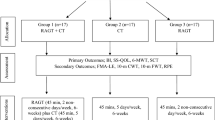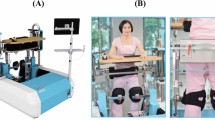Abstract
The effects of caregiver burden during the inpatient rehabilitation period have not yet been investigated. The purpose of this study was to evaluate the burden on stroke survivors' caregivers during the inpatient rehabilitation period, and to compare the associations of robot-assisted gait training and conventional therapy with caregiver burden. Our randomized, crossover, prospective study included 63 stroke survivors and their caregivers, who were randomly assigned to one of two groups. The patients in group I received robot-assisted gait training for 2 weeks, followed by conventional therapy for a further 2 weeks. The patients in group II received conventional therapy for 2 weeks followed by robot-assisted gait training for a further 2 weeks. The caregiver burden inventory, beck depression index, and beck hopelessness scale were administered to the caregivers at day 0, on the “switch day” (day 15), and day 30. Before inpatient rehabilitation, 18 (35%) of the caregivers had somewhat elevated scores on the caregiver burden inventory; however, at the end of rehabilitation, 42 (66.6%) of the caregivers were in a high-burden state. The caregiver burden inventory scores differed significantly between baseline and the end of rehabilitation in both groups. Caregiver depression scores also increased significantly in both groups (p < 0.0001), while hopelessness scores increased only in group II (p = 0.027). Caregiver burden increased during the inpatient stroke rehabilitation period. During inpatient rehabilitation, both robot-assisted gait training and conventional therapy increased caregiver burden.
ClinicalTrials.gov Number NCT03535467, First Posted: 24 May 2018.


Similar content being viewed by others
References
Etters L, Goodall D, Harrison BE (2008) Caregiver burden among dementia patient caregivers: a review of the literature. J Am Acad Nurse Pract 20(8):423–428
Clyburn LD, Stones MJ, Hadjistavropoulos T, Tuokko H (2000) Predicting caregiver burden and depression in Alzheimer’s disease. J Gerontol B Psychol Sci Soc Sci 55(1):S2–S13
Carod-Artal J, Egido JA, González JL, Varela de Seijas E (2000) Quality of life among stroke survivors evaluated 1 year after stroke: experience of a stroke unit. Stroke 31(12):2995–3000
Guzik A, Bushnell C (2017) Stroke epidemiology and risk factor management. Continuum 23(1, Cerebrovascular diesease):15–39 (Lifelong Learning in Neurology)
Mustafaoğlu R, Erhan B, Yeldan İ, Hüseyinsinoğlu BE, Gündüz B, Özdinçler AR (2018) The effects of body weight-supported treadmill training on static and dynamic balance in stroke patients: a pilot, single-blind, randomized trial. Turk J Phys Med Rehab 64(4):344
Morone G, Paolucci S, Cherubini A, De Angelis D, Venturiero V, Coiro P, Iosa M (2017) Robot-assisted gait training for stroke patients: current state of the art and perspectives of robotics. Neuropsychiatr Dis Treat 13:1303
Camak DJ (2015) Addressing the burden of stroke caregivers: a literature review. J Clin Nurs 24(17–18):2376–2382
Hesse S, Waldner A, Tomelleri C (2010) Innovative gait robot for the repetitive practice of floor walking and stair climbing up and down in stroke patients. J Neuroeng Rehabil 7(1):30
Dundar U, Toktas H, Solak O, Ulasli A, Eroglu S (2014) A comparative study of conventional physiotherapy versus robotic training combined with physiotherapy in patients with stroke. Top Stroke Rehabil 21(6):453–461
Shah S, Vanclay F, Cooper B (1989) Improving the sensitivity of the Barthel Index for stroke rehabilitation. J Clin Epidemiol 42(8):703–709
Kucukdeveci A, Yavuzer G, Tennant A, Suldur N, Sonel B, Arasil T (2000) Adaptation of the modified Barthel Index for use in physical medicine and rehabilitation in Turkey. Scand J Rehab Med 32(2):87–92
Novak M, Guest C (1989) Application of a multidimensional caregiver burden inventory. Gerontologist 29(6):798–803
Küçükgüçlü Ö, Aynur E, Yener G (2009) The reliability and validity of the caregiver burden inventory in Turkey. J Neurol Sci Turk 26(1):60–73
Beck AT, Ward CH, Mendelson M, Mock J, Erbaugh J (1961) An inventory for measuring depression. Arch Gen Psychiatry 4(6):561–571
Beck AT, Weissman A, Lester D, Trexler L (1974) The measurement of pessimism: the hopelessness scale. J Consult Clin Psychol 42(6):861
Durak A, Palabıyıkoğlu R (1994) Beck umutsuzluk ölçeğinin geçerlik ve güvenirlik çalışması (the validity and reliability of the Beck hopelessness scale). Kriz Dergisi 2:311–319
Hisli N (1989) Beck depresyon envanterinin universite ogrencileri icin gecerligi, guvenirligi. Psikoloji Dergisi 7(23):3–13
Pucciarelli G, Vellone E, Savini S, Simeone S, Ausili D, Alvaro R, Lee CS, Lyons KS (2017) Roles of changing physical function and caregiver burden on quality of life in stroke: a longitudinal dyadic analysis. Stroke 48(3):733–739
Adelman RD, Tmanova LL, Delgado D, Dion S, Lachs MS (2014) Caregiver burden: a clinical review. JAMA 311(10):1052–1060
Yilmaz Yalcinkaya E, Önes K, Bora Ayna A, Kucukali Turkyilmaz A, Erden N (2010) Low back pain prevalence and characteristics in caregivers of stroke patients: a pilot study. Top Stroke Rehabil 17(5):389–393
Zarit SH, Todd PA, Zarit JM (1986) Subjective burden of husbands and wives as caregivers: a longitudinal study. Gerontologist 26(3):260–266
Elmståhl S, Malmberg B, Annerstedt L (1996) Caregiver’s burden of patients 3 years after stroke assessed by a novel caregiver burden scale. Arch Phys Med Rehabil 77(2):177–182
Jaracz K, Grabowska-Fudala B, Górna K, Jaracz J, Moczko J, Kozubski W (2015) Burden in caregivers of long-term stroke survivors: prevalence and determinants at 6 months and 5 years after stroke. Patient Educ Couns 98(8):1011–1016
Pucciarelli G, Ausili D, Galbussera AA, Rebora P, Savini S, Simeone S, Alvaro R, Vellone E (2018) Quality of life, anxiety, depression and burden among stroke caregivers: a longitudinal, observational multicentre study. J Adv Nurs 74(8):1875–1887
Malhotra R, Chei C-L, Menon E, Chow WL, Quah S, Chan A, Matchar DB (2016) Short-term trajectories of depressive symptoms in stroke survivors and their family caregivers. J Stroke Cerebrovasc Dis 25(1):172–181
Byun E, Evans L, Sommers M, Tkacs N, Riegel B (2019) Depressive symptoms in caregivers immediately after stroke. Top Stroke Rehabil 26(3):187–194
Hu P, Yang Q, Kong L, Hu L, Zeng L (2018) Relationship between the anxiety/depression and care burden of the major caregiver of stroke patients. Medicine (Baltimore) 97(40):e12638
Backx APM, Spooren AIF, Bongers-Janssen HMH, Bouwsema H (2018) Quality of life, burden and satisfaction with care in caregivers of patients with a spinal cord injury during and after rehabilitation. Spinal Cord 56(9):890
Lo K, Stephenson M, Lockwood C (2017) Effectiveness of robotic assisted rehabilitation for mobility and functional ability in adult stroke patients: a systematic review. JBI Database Syst Rev Implement Rep 15(12):3049–3091
Author information
Authors and Affiliations
Corresponding author
Ethics declarations
Conflict of interest
There is nothing to declare as a competing interest for any of the authors including the corresponding author.
Ethical approval
All procedures performed in studies involving human participants were in accordance with the ethical standards of the institutional and/or national research committee and with the 1964 Helsinki declaration and its later amendments or comparable ethical standards. This study was approved by the local ethics committee.
Informed consent
Informed consent was obtained from all individual participants included in the study.
Additional information
Publisher's Note
Springer Nature remains neutral with regard to jurisdictional claims in published maps and institutional affiliations.
Rights and permissions
About this article
Cite this article
Guler, M.A., Erhan, B. & Yilmaz Yalcinkaya, E. Caregiver burden in stroke inpatients: a randomized study comparing robot-assisted gait training and conventional therapy. Acta Neurol Belg 121, 729–736 (2021). https://doi.org/10.1007/s13760-020-01465-5
Received:
Accepted:
Published:
Issue Date:
DOI: https://doi.org/10.1007/s13760-020-01465-5




